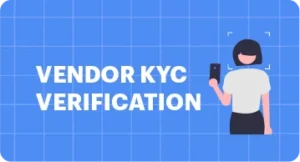Optimizing Credit Card Onboarding with Video KYC
Introduction
Credit card onboarding, a crucial process in the financial industry, can often be a source of frustration and complexity for both financial institutions and customers alike. However, innovative solutions like Video KYC have emerged to address these challenges, streamlining the onboarding process and enhancing security. In this comprehensive guide, we will explore the pain points associated with credit card onboarding, delve into how Video KYC can effectively address these issues, and highlight the numerous benefits it brings to the onboarding process. We will also provide best practices for implementing Video KYC to ensure a smooth and secure customer experience.
Pain Points in Credit Card Onboarding
Before we explore the solutions offered by Video KYC, it is essential to understand the pain points that have traditionally plagued credit card onboarding processes:
Complex and Lengthy Procedures:
- Traditional credit card onboarding processes often involve a multitude of steps, including filling out extensive paperwork, providing various forms of identification, and sometimes even visiting a physical branch.
- Applicants are required to gather a plethora of documents such as proof of identity, proof of address, income documents, and more, making the process time-consuming and overwhelming.
- The complexity of these procedures can discourage potential applicants who may opt for simpler alternatives or delay their applications, affecting the bank’s customer acquisition rate.
High Application Abandonment Rates:
- Due to the cumbersome nature of traditional onboarding processes, many applicants tend to abandon their credit card applications before completion.
- The lengthy and convoluted paperwork, combined with the need to visit a physical branch in some cases, results in a high dropout rate. This not only wastes the applicant’s time but also impacts the bank’s revenue and growth potential.
Data Accuracy and Document Verification:
- Verifying the authenticity of customer-provided documents and the accuracy of the information can be challenging and prone to errors in manual processes.
- The human element in document verification introduces the risk of data entry mistakes or misinterpretation of documents.
- These inaccuracies can lead to compliance issues and delays in the approval process, negatively affecting the bank’s operational efficiency and customer satisfaction.
Security and Fraud Concerns:
- Traditional onboarding methods may not provide the robust security measures needed to prevent identity theft and fraud.
- Fraudsters often exploit vulnerabilities in the process, such as using forged documents or impersonating applicants.
- Inadequate security measures can result in financial losses, damage to the bank’s reputation, and legal liabilities.
Customer Experience:
- Lengthy, paperwork-heavy onboarding processes create a poor customer experience.
- Today’s customers, accustomed to digital convenience, expect a seamless and efficient application process. When faced with cumbersome procedures, they may become frustrated and dissatisfied.
- A dissatisfied customer is less likely to engage with the bank’s other services and may even switch to competitors offering a more straightforward onboarding experience.
These pain points in credit card onboarding highlight the need for a more streamlined, efficient, and secure process. Video KYC, as a solution, addresses these challenges by simplifying the onboarding journey, reducing abandonment rates, enhancing data accuracy, improving security, and ultimately providing a better customer experience. Let’s take a close look:
Addressing Pain Points with Video KYC
Simplified Onboarding:
- Video KYC simplifies the onboarding process by leveraging video calls to verify customer identities and collect required information.
- Customers can participate in a video call with trained agents or AI-powered bots, guiding them through the KYC process step by step.
- This eliminates the need for extensive paperwork and reduces the complexity of the application process, making it more user-friendly and accessible.
Reduced Abandonment Rates:
- Video KYC significantly reduces the likelihood of application abandonment by providing a convenient and efficient onboarding experience.
- With Video KYC, customers can complete the KYC requirements in real-time from the comfort of their own devices, eliminating the need for time-consuming visits to a physical branch.
- The streamlined process encourages applicants to complete their applications, reducing dropout rates and improving the bank’s customer acquisition rates.
Enhanced Data Accuracy:
- Video KYC incorporates advanced AI and machine learning algorithms to verify the authenticity of documents and the accuracy of customer-provided information.
- These algorithms can quickly and accurately validate documents such as passports, driver’s licenses, utility bills, and more, reducing the risk of errors and inaccuracies.
- Enhanced data accuracy not only speeds up the verification process but also ensures compliance with regulatory requirements, mitigating potential compliance issues.
Improved Security:
- Video KYC enhances security by conducting real-time video calls with customers. During these calls, trained agents or AI systems can visually verify the customer’s identity by comparing them to the documents provided.
- Biometric authentication, such as facial recognition, fingerprint scans, or voice recognition, adds an extra layer of security. These methods are difficult to forge or replicate, making it exceedingly challenging for fraudsters to impersonate someone else.
- The robust security measures in Video KYC help protect against identity theft and fraud, safeguarding the bank and its customers.
Enhanced Customer Experience:
- Video KYC offers a personalized and convenient experience that aligns with the expectations of today’s digital-savvy customers.
- Customers can complete the KYC process from the comfort of their homes or offices, eliminating the need for in-person visits and extensive paperwork.
- During the video call, customers can ask questions and receive real-time assistance, enhancing their overall experience and satisfaction with the onboarding process.
This innovative solution represents a significant step forward in optimizing credit card onboarding, benefiting both financial institutions and their customers.
To successfully implement Video KYC and harness its benefits, financial institutions should follow these best practices:
Compliance with Regulatory Requirements:
- Staying compliant with local and international regulations is paramount when implementing Video KYC. Regulations related to customer data privacy and financial transactions may vary from region to region.
- Financial institutions should invest in continuous monitoring of regulatory changes to ensure that their Video KYC processes remain compliant. This includes keeping abreast of developments in regulations like the European Union’s General Data Protection Regulation (GDPR) and the USA’s Bank Secrecy Act (BSA).
- Regularly reviewing and updating Video KYC processes to align with changing legal requirements is essential to avoid potential legal and financial penalties.
User Education and Support:
- Customer education is crucial to ensure a smooth Video KYC onboarding experience. Financial institutions should provide clear, concise, and user-friendly instructions on how to complete the Video KYC process.
- Offering accessible customer support channels, such as chat, email, or phone support, is essential to assist users during the process. Promptly addressing queries and issues can help prevent customer frustration and abandonment.
- Financial institutions can also create informative resources, such as video tutorials or FAQs, to guide customers through the Video KYC journey.
Integration with Existing Systems:
- Seamless integration of Video KYC with existing onboarding systems is key to achieving operational efficiency. Compatibility ensures that the onboarding process flows smoothly without disruptions or bottlenecks.
- Financial institutions should work closely with their IT and technical teams to ensure that Video KYC can integrate with their current infrastructure. This integration should encompass customer relationship management (CRM) systems, databases, and any other relevant components.
- Compatibility with existing systems not only enhances efficiency but also reduces the risk of errors and data inconsistencies.
Data Security and Privacy:
- Protecting customer data and privacy is a top priority. Financial institutions should implement robust data security measures throughout the Video KYC process.
- Encryption protocols, such as SSL/TLS, should be used to secure data during transmission and storage. This ensures that customer data remains confidential and protected from unauthorized access.
- Implementing strict data access policies is critical to controlling who can access sensitive customer information. Role-based access controls should be in place to limit access to authorized personnel only.
In summary, successful implementation of Video KYC hinges on adhering to best practices in compliance, user education, system integration, and data security. Financial institutions that prioritize these practices not only enhance the effectiveness of their Video KYC processes but also demonstrate their commitment to customer privacy and regulatory compliance. This fosters trust among customers and helps create a positive onboarding experience.To further explore how video KYC can optimize the onboarding process and enhance customer experiences, check out our blog ‘VIPV KYC: The Comprehensive Guide to Video In Person Verification.’
Conclusion
Credit card onboarding, traditionally burdened with complexity and inefficiency, has found a powerful ally in Video KYC. By addressing the pain points associated with this crucial process, Video KYC simplifies onboarding, reduces abandonment rates, enhances data accuracy, and improves security. Additionally, it elevates the overall customer experience, aligning with the expectations of today’s digital-savvy customers.
Embracing Video KYC not only streamlines credit card onboarding but also leads to numerous benefits, including efficiency gains, enhanced security, customer convenience, cost savings, and regulatory compliance. By following best practices and leveraging solutions like Video KYC, financial institutions can optimize the credit card onboarding process, ensuring a seamless, secure, and customer-centric journey for their applicants.
In conclusion, the adoption of Video KYC represents a pivotal step towards a more efficient, secure, and customer-focused credit card onboarding process in the digital age. It is essential to consider solutions like MSB Docs Video KYC to further exemplify the potential for innovation in credit card onboarding, ultimately benefiting both financial institutions and their customers.
Ready to enhance your credit card onboarding process and ensure compliance? Discover how Video KYC can streamline your operations. Take the next step with MSB Docs today to revolutionize your onboarding process. Request a demo or book your free trial now and witness the future of seamless customer onboarding.
FAQs
1. What is Video KYC, and how does it differ from traditional KYC processes?
Video KYC, or Video Know Your Customer, is a digital onboarding process that allows customers to complete KYC requirements through video calls. Unlike traditional KYC processes that involve extensive paperwork and in-person visits, Video KYC simplifies the process by leveraging real-time video calls, reducing complexity and enhancing convenience.
2. Is Video KYC secure, and how does it protect against fraud and identity theft?
Yes, Video KYC is highly secure. It enhances security by conducting real-time video calls with customers, making it difficult for fraudsters to impersonate someone else. Additionally, biometric authentication methods such as facial recognition and fingerprint scans add an extra layer of security, further safeguarding against identity theft and fraud.
3. Can Video KYC be integrated with existing onboarding systems used by financial institutions?
Yes, Video KYC can be seamlessly integrated with existing onboarding systems used by financial institutions. Compatibility and harmonization with current infrastructure ensure operational efficiency and a smooth customer experience. It is essential for financial institutions to work closely with their IT and technical teams to facilitate this integration.
4. What are the regulatory requirements that financial institutions need to consider when implementing Video KYC?
Financial institutions must stay compliant with local and international regulations governing KYC. Regulations related to customer data privacy and financial transactions may vary by region. It is crucial for institutions to continuously monitor regulatory changes and ensure that their Video KYC processes align with these legal requirements.
5. How does Video KYC improve the customer experience during credit card onboarding?
Video KYC enhances the customer experience by offering a personalized and convenient onboarding process. Customers can complete KYC requirements from the comfort of their homes or offices, eliminating the need for in-person visits and extensive paperwork. During the video call, customers can ask questions and receive real-time assistance, further improving their overall satisfaction with the onboarding process.





